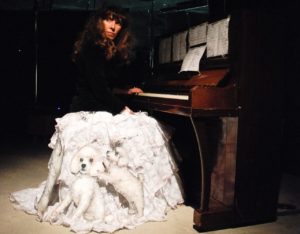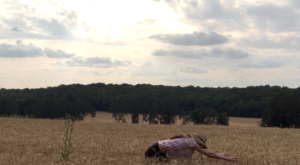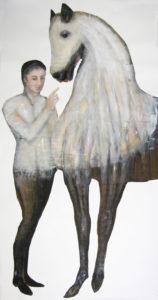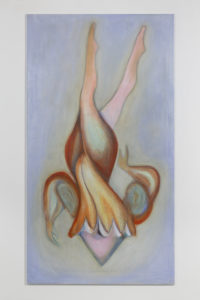Prix AWARE
© Photo: JP Rosier

Mathilde Rosier, Play for a Stage of the Natural Theatre of Cruelty Performance view at Serpentine Gallery Pavilion, London, UK, 2009
The way Mathilde Rosier works finds its starting point in a key aspect of her biography: the decision which led her at the end of her studies at the Beaux-Arts in Paris, to retire to an isolated building at the heart of a rural and agricultural environment, which has been the central subject of her work for the last 20 years.
This radical and deliberate choice – which was in no way practical or strategic after the promising beginnings of her career and two successive international residencies [which allowed for art world connections] at the Rijksakademie in Amsterdam and the ISCP in New York – filled firstly the feeling of a ‘lack’, of an estrangement from the living, and also offered the possibility, in an environment removed from cultural institutions, to leave the space for another type of culture, in this case an agri/cultural regime almost entirely absent from the field of art at the time. At the heart of a region shared between wine estates and large farms, this new, solitary, way of living – precursor of the return to the land which is now at the centre of current affairs – anchored the day-to-day life of the artist, both in the diversity of relationships with living things, and in a confrontation with the self.

Mathilde Rosier, Abstraction Attraction III, 2015, Performance views at Volcano Extravaganza, Stromboli, Italy, 2015
In the first phase of this research, the artist turned to the history of psychology and to the hypothesis that the only authentic link to nature lies in the unconscious, a relic of our primitive state which contrasts with the civilised and conscious self. It is expressed by Mathilde Rosier through its appearance in the form of dramatised, ambiguous scenes, recalling fairy tales or mythology, in which sometimes indistinct human figures coexist with more or less familiar animals: pets (dogs, cats, horses), commensals (owls placed on cardboard decorations, musical monkeys) or wild but captive animals, like those felines or macaws, restricted to the bounds of a wardrobe or of a four-post bed, respectively.

Mathilde Rosier, Le Massacre du Printemps, 2020 4K video; 18’ 9” Courtesy of the Artist and Galleria Raffaella Cortese, Milan

Mathilde Rosier, Body and Soil, 2020 Video; 4’ 43” Courtesy of the Artist and Galleria Raffaella Cortese, Milan

Mathilde Rosier, Cérémonie, Homme et Cheval, 2010 Gouache on paper; 203 × 106 cm. Courtesy of the Artist and Galleria Raffaella Cortese, Milan
For a few years now, these representations of domesticated nature have continued in a new series, where hybrid bodies topped with ears of corn, blown by the winds, between the rows of cereal plants and the marks left by agricultural machinery, bud with vegetal limbs. Grouped together under the title In the Fields of Intensive Prosperity (2019-2021), these images evoke simultaneously the mental experience of dissolution in living things which the artist submits to, the intensity of her link with her environment, and that which is induced by industrial agricultural methods; the immediate kinship between plant and human, and the intensive exploitation of one by the other. If her earlier works were ways of communing with the world, these works are about becoming one with it.

Mathilde Rosier, Blind Swim 3, 2016-2017, Oil on canvas, 220 × 120 cm Courtesy of the Artist and Galleria Raffaella Cortese, Milan

Mathilde Rosier, Impersonal Empire, the Buds Installation view at Galleria Raffaella Cortese, via A. Stradella 7, Milan, Italy, 2018
Whether treated through paintings, drawings, assemblages, films, costumes, or performances, this theme continues to express itself, in a way which could recall symbolist art, the decorative art of the theatre or ballet, or even the ornaments common in certain Indigenous works. But it is also counterintuitive to think that these images refer to anything but themselves. Rather, they are proof of an “art of attention”, to use Estelle Zhong Mengual’s phrase about naturalist women of the 21st century, who consider nature as a subject and who celebrate a return to it.
Thierry Leviez
Mathilde Rosier was born in Paris in 1973. She lives and works in Burgundy. She is a professor at the Fachhochschule Nordwestschweiz in Basel. She studied at the Beaux-Arts in Paris after a master’s degree in economics at Paris-Dauphine University, then was a resident at the Rijksakademie in Amsterdam in 2002 and at The International Studio & Curatorial Program (ISCP) in New York in 2006. Her work has been the subject of numerous personal exhibitions, notably at the Freud Museum and the Camden Art Center in London (2011), at the Kunstverein in Dortmund (2012), at the Tank Institut Kunst in Basel (2016), at the gallery The Breeder in Athens, at the Fondazione Guido Lodovico Luzzatto and at the Galleria Raffaella Cortese in Milan (2018), at the Fundacja Razem Pamoja in Warsaw (2019), as well as at the Museu de Arte de São Paulo (MASP) in Sao Paulo and at the Museo d’Arte Contemporanea Donnaregina (MADRE) in Naples (2020).
Her last exhibition in France was presented in 2010 at the Jeu de Paume.
Translated from French by Eléonore Besse.
Tous droits réservés dans tous pays/All rights reserved for all countries.






